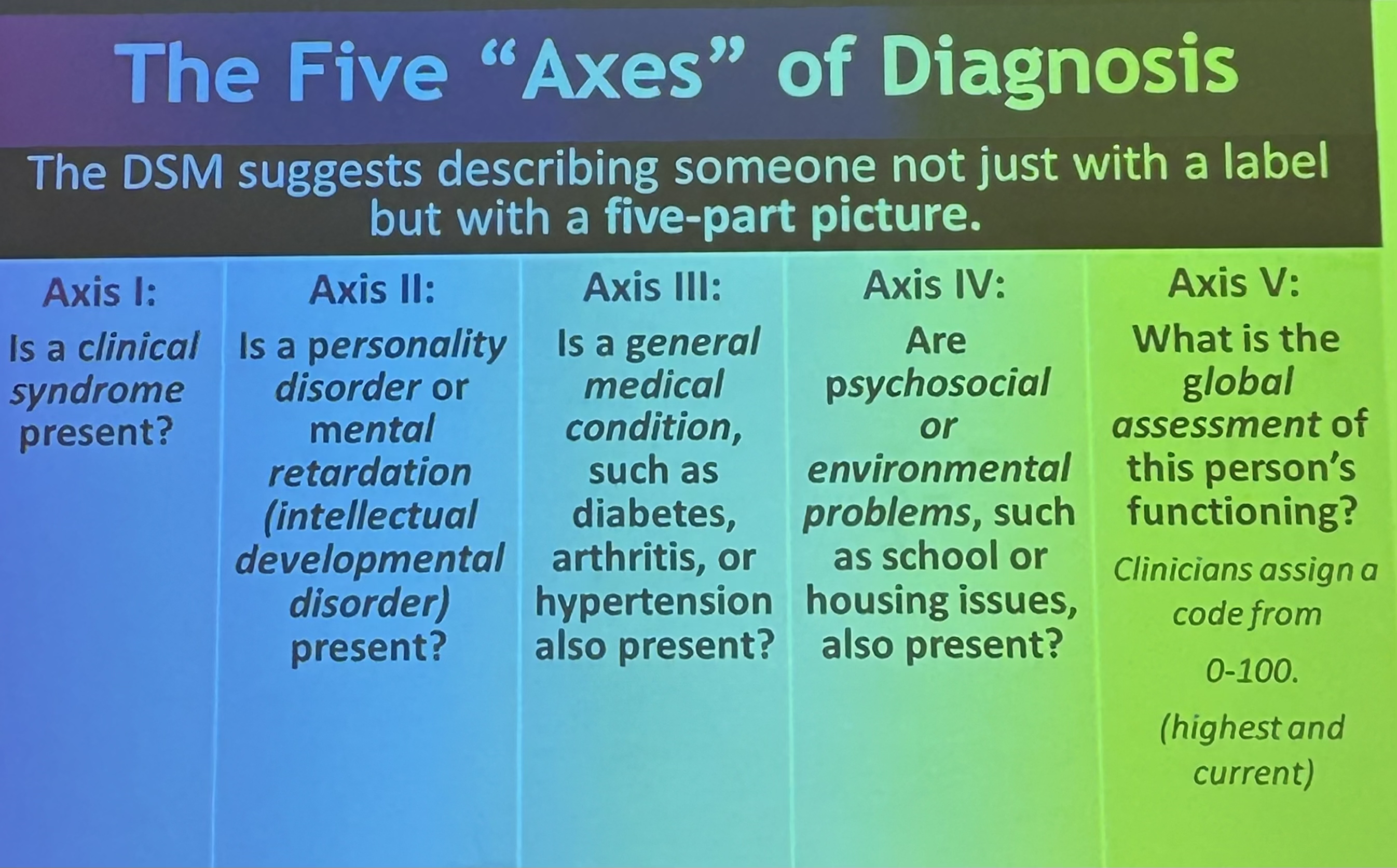Psychopathology
Psychological disorders- deviant, distressful, and dysfunctional patterns or thought, feelings, and actions.
defined by culture and context
Can change over time
Psychopathology- scientific study of origins, symptoms, and development of psychological disorders
Abnormal behavior
deviant (atypical)
Maladaptive (dysfunctional)
Personally distressing (despair)
Biological approach
bio origin
Psychological approach
experiences, thoughts, emotions, personality
Sociocultural approach
Social context
Some culture bound disorders
Bulimia nervosa: binging/ purging, in the US
Running amok: violent outbursts, in Malaysia
Hikikomori: social withdrawal, in Japan
Biopsychosocial approach
all 3
Vulnerability-Stress Hypothesis
Pre-existing genetic conditions + stressful experiences
Nature/Nurture’
DSM-5 TR
Classifying disorders: describes a disorder, predict its course, imply appropriate treatment, stimulate research into causes
DSM is the diagnostic classification tool
 Advantages of DSM-5
Advantages of DSM-5
common basis for communication
Helps clinicians make predictions
Naming the disorder can provide comfort
Disadvantages of DSM-5
stigma
Treats psychological disorders as medical illnesses
Focuses on weaknesses
Promotes over-diagnosis
Too subjective, culturally laden
Dangers of Labeling
bias perceptions and change reality
Arbitrary and betray judgements
Self-fulfilling prophecies
Stigmatize people with disorders and add to stereotypes
Rosenhan’s study- fake psychiatric patients
Negative attitudes toward mentally ill
People with mental health diagnosis are more likely to be the victims of violence
Physical health risks
Comorbidity with addictions
Anxiety Disorder
Uncontrollable fears that are disproportionate and disruptive
GAD- individual is continually fearful and in a state of autonomic nervous system arousal
Persistent for 6 months
Inability to specify reasons for anxiety
Bio factors: gene predisposition, GABA deficiency
Psychological and sociocultural factors: harsh self-standards, critical parents, neg thoughts, trauma
Panic disorder- unpredictable minutes-long episodes of intense dread
Without warning
Bio factors: norephinehrine, GABA
Psychological: conditioning to CO2,
Sociocultural: gender differences
Panic attacks are recurrent, so people can develop fears of panic attacks and avoid particular situations
Specific phobias- irrational fear of particular object or situation
Psychological- learned
Biological- genetic disposition
OCD- persistant anxiety-provoking thoughts and/or urges to perform repetitive, ritualistic behaviors
Hoarding
Skin picking
Hair pulling
Body dysmorphic disorder
Trauma and Stress related disorders- Single horrific experiences or a pattern of negative experiences
PTSD- symptoms develop as a result of exposure to a traumatic event, oppressive situation, natural/unnatural disasters.
Flashbacks
Avoidance of emotional experiences- numbness
Excessive startle
Difficulties with memory and concentration
Impulsive outbursts
people who have less control of the situation, more trauma, smaller amygdala, genetic disposition are more likely to get PTSD.
Dissociative disorders- sudden loss of memory or change in identity
Dissociative amnesia
Dissociative identity disorder
Mood disorders- significant and persistent disruptions in mood or emotions that cause impaired cognitive, behavioral, and physical functioning
Biological aspects- depressed gene regions, heritability studies, brain activity diminished with depression/ high with mania, more norphinephrine in mania/ less in depression
social-cognitive aspects
Major Depressive Disorder- significant depressive episode that lasts at least 2 weeks
Fatigue, sense of worthlessness, reduced interest, appetite and sleep disturbances
Regulation of neurotransmitters, learned helplessness, pessimistic attribution, poverty, in marginalized group
Bipolar Disorder- characterized by extreme mood swings that include mania
Episodes usually separated by six months to a year
Psychosis- state where a persons perceptions and thoughts are fundamentally removed from reality. Symptom, not illness
Schizophrenia- the mind is split from reality
Positive symptoms (adding of behaviors)- hallucinations, delusions, disorganized speech and thoughts, bizarre behaviors
Negative symptoms (subtracting of healthy behaviors)- flat affect, reduced social interaction, less motivation, catatonia (moving less)
Onset and development
Acute/ reactive schizophrenia— in reaction to stress, develop positive symptoms. Recovery is likely
Chronic/ process schizophrenia— develops slowly with more negative symptoms.
With treatment and support, there may be periods of a normal life, but no cure
Without treatment, leads to poverty and social problems
Causes
Genetics, neurodevelopmental abnormalities, stressful life experiences, continued neural degeneration, brain abnormalities
Sociocultural factors in suicide
chronic economic hardship
Male
Nonsuicidal self-injury (NSSI)
cutting, burning, hitting
Tend to experience bullying
Reasons:
Gain relief from intense negative thoughts through distraction of pain
Attract attention and possibly get help
Relieve guilt by punishing themselves
Get others to change their negative behavior
Fit in with peer group